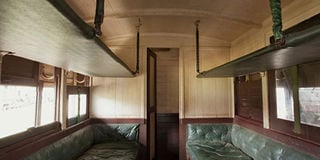Colonial narrative dominates the city’s museums

A passenger carriage at the railway museum in Nairobi, Kenya. Photo/FILE
What you need to know:
- Telegraphic equipment, creaky telephones and manual typewriters jostle for attention with yellowing, dog-eared maps, pressure lamps, photos and furniture in a dizzying display of flea market ephemera.
- Missing only are the Lord Delameres, the Ewart Grogans and their coterie of gin-swilling, gun-slinging aristocrats as modern projections of England’s antiquated social hierarchy of medieval entitlement.
- For those with imperial nostalgia, it was a gracious epoch of first-class coach travel with gourmet food in fancy dining cars as the trains chugged through enchanting game-filled wilderness.
For nearly four decades, Nairobi held me close. Yet walking south, away from old Station Road (now Moi Avenue), past the second-generation railway terminus along an embankment of gnarled jacarandas, nothing prepared me for the spectral scene of spooked Victorian-Edwardian decay.
More archaeological site, heartbreak and humour than elemental nucleus, the lost town of crumbling warehouses and rusting locomotives of Kenya’s once totemic Uganda Railway are reduced to museum artefacts.
With names like Maasai of Kenya, UR (Uganda Railways), KUR (Kenya and Uganda Railways) and EAR (East African Railways), the trains are stark reminders of the city’s history intertwined with that of its neighbours.
Nearby stand railway houses on whose verandas European officials sat not so long ago.
A renovated warehouse that escaped the destructive building boom is the Railway Museum, and in the cobwebbed gloom of this shrine to Britain’s short, century-long imperial adventure in East Africa, the outdated apparatus of its bureaucracy lies on long tables.
Would once again the colonial conceit of the railway catalysing the city’s beginnings be recycled?
Or would a whistle blower have offered the necessary caveats and correctives to the colonialists?
After visits to Nairobi’s Railway, National and Karen Blixen Museum, it beggars belief that after 50 years of Independence in a place where a sprawling community of four million city dwellers has seized centre stage, Britain’s colonial narrative still has a stranglehold over the city’s museum fare with its deadening commonplaces, convenient fictions and standard unsubstantiated generalities that once littered the city’s historiographical landscape.
Our unflappable guide gives the Uganda Railways with its segregated — natives in third class — compartments, an admiration it hardly deserves, the orderly assemblage of rusting relics, the machinery of empire, a saga resting on its own merit.
Telegraphic equipment, creaky telephones and manual typewriters jostle for attention with yellowing, dog-eared maps, pressure lamps, photos and furniture in a dizzying display of flea market ephemera.
Not to be outclassed, the King’s porcelain, silverware in dusty cabinets and imported chairs reflect the essential needs of Europe’s moneyed elite on safari in Kenya, distractions that trivialise the railway as a fundamental component in the context of Britain’s colonial urban policy.
Missing only are the Lord Delameres, the Ewart Grogans and their coterie of gin-swilling, gun-slinging aristocrats as modern projections of England’s antiquated social hierarchy of medieval entitlement.
IMPERIAL NOSTALGIA
For those with imperial nostalgia, it was a gracious epoch of first-class coach travel with gourmet food in fancy dining cars as the trains chugged through enchanting game-filled wilderness.
The railway cargo-carriers, the rickshaw pullers straining against the weight of passengers and so many other labourers for whom selling their sweat for survival wages began in the colonial era and is still a harsh reality for many — all this has no place in the guide’s story.
There is more. Ansonia clocks manufactured in New York, their reliable tick-tock a familiar sound on early 20th century walls in Nairobi and Manhattan, are nice to look at, their exchange in trade for slaves, elephant ivory and guns nowhere to be found.
In a photo, former American president Theodore Roosevelt, avatar of that nation’s own programme of imperial expansionism, looks swell enjoying the view from the engine seat.
It reveals that by l910, not only was a strong American presence being felt in Nairobi but Britain was already offering the railway as the beginning of its official town narrative — the value of the Kenya-Uganda Railway confirmed as of being unambiguous benefit to the opening up of East Africa.
As the East African Railways Corporation included Harbours, there are items salvaged from the wreck of the Konigsberg, the German frigate scuttled by its crew before being sunk in l915 by the British Navy in Tanzania’s Rufiji River Delta.
A lovely table, matching sideboard and chairs of honey-coloured hardwood are just some of the elegant furniture on display.
This story first appeared in the East African. CLICK HERE to read the rest of the article.




